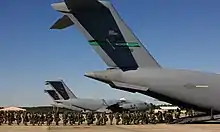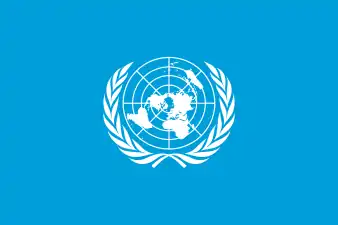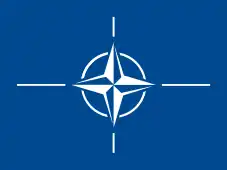Rapid reaction force
A rapid reaction force / rapid response force (RRF), quick reaction force / quick response force (QRF), immediate reaction force (IRF), rapid deployment force (RDF) or quick maneuver force (QMF) is a military or police unit capable of responding to emergencies in a very short time frame.

When used in reference to law enforcement and security forces, such as police tactical units, the time frame is usually minutes, while in military applications, such as paratroopers or commandos, the time frame can be minutes, hours or days. Rapid reaction forces are designed to intervene quickly as a spearhead to gain and hold ground in quickly unfolding combat or low-intensity conflicts, such as uprisings that necessitate the evacuation of foreign embassies.
They are usually transported by air. Rapid reaction forces are usually lightly armed—limited to small arms and light crew-served weapons, and lacking vehicles, armor, and heavy equipment—but are often very well-trained to compensate.
Types
Rapid reaction force
_staging_area_at_Camp_Buehring%252C_Kuwait_circa_2005.jpg.webp)
A rapid reaction force is an armed military unit capable of rapidly responding to developing situations, usually to assist allied units in need of assistance. They are equipped to respond to any type of emergency within a short time frame, often only a few minutes, based on unit standard operating procedures (SOPs).[1] Cavalry units are frequently postured as rapid reaction forces, with a main mission of security and reconnaissance.[2][3] They are generally platoon-sized in the U.S. military's combat arms.
A rapid reaction force is a military reserve unit that belongs directly to the commander of the unit it is created from.[4] Depending on the unit size and protocols, the commander may be the only person authorized to control a RRF, or they may delegate this responsibility to one or more additional people. RRFs are commonly found in maneuver battalion-level task forces and above, in addition to many operating bases having their own dedicated RRF to react to threats on or immediately around the base.
The readiness level of a RRF is based on unit SOPs. Since maintaining extremely high levels of readiness is draining on equipment, resources, and personnel, a RRF is postured based on the likelihood of being called up. During a high-intensity conflict, a RRF may be forced to maintain high readiness, with all members waiting in their vehicles to respond. However, during a low-intensity conflict, when deployment is less likely and may be more readily predicted, command establishes how fast a RRF must be able to react, which can range from vehicles and personnel in a central location with the troops rotating regularly, to the vehicles staged close to a unit area with all personnel staying close enough for rapid recall. The speed at which a RRF is expected to react is defined by its readiness condition level.
The mission of a RRF can vary widely, as they are used to respond to any threat the commander chooses to employ them for. Depending on the mission requirement, additional units can be attached to an organic platoon to expand their capabilities. Examples include attaching explosive ordnance disposal teams to a RRF responding to bombs or similar threats, and vehicle recovery assets to a RRF expected to recover damaged trucks
Rapid deployment force
A rapid deployment force (RDF) is a military formation that is capable of fast deployment outside their country's borders. Rapid deployment forces typically consist of well-trained military units (special forces, paratroopers, marines, etc.) that can be deployed fairly quickly.
List
Rapid reaction force

 The concept of a United Nations rapid reaction force was proposed in the mid-1990s by several commentators and officials, including Secretary-General Boutros Boutros-Ghali. The UN rapid reaction force would consist of personnel stationed in their home countries, but they would have the same training, equipment, and procedures, and would conduct joint exercises. The force would remain at high readiness at all times so as to quickly deploy them where necessary.[5]
The concept of a United Nations rapid reaction force was proposed in the mid-1990s by several commentators and officials, including Secretary-General Boutros Boutros-Ghali. The UN rapid reaction force would consist of personnel stationed in their home countries, but they would have the same training, equipment, and procedures, and would conduct joint exercises. The force would remain at high readiness at all times so as to quickly deploy them where necessary.[5] The Allied Rapid Reaction Corps (ARRC) is a NATO rapid reaction force, established in 1992. A successor to the British Army's I Corps, the ARRC is capable of rapidly deploying a NATO headquarters for operations and crisis response.[6]
The Allied Rapid Reaction Corps (ARRC) is a NATO rapid reaction force, established in 1992. A successor to the British Army's I Corps, the ARRC is capable of rapidly deploying a NATO headquarters for operations and crisis response.[6] The European Gendarmerie Force (EUROGENDFOR) is a European rapid reaction force under the European Union, established in 2006. An alliance of gendarmerie forces from Italy, France, the Netherlands, Poland, Portugal, Romania, and Spain, it serves as a unified intervention force of European militarized police.[7]
The European Gendarmerie Force (EUROGENDFOR) is a European rapid reaction force under the European Union, established in 2006. An alliance of gendarmerie forces from Italy, France, the Netherlands, Poland, Portugal, Romania, and Spain, it serves as a unified intervention force of European militarized police.[7] The European Rapid Operational Force (EUROFOR) was a European rapid reaction force under the European Union and Western European Union, established in 1995 and composed of military units from Italy, France, Portugal, and Spain. EUROFOR was tasked with performing duties outlined in the Petersberg Tasks. EUROFOR deployed to Kosovo from 2000 to 2001, and North Macedonia as part of EUFOR Concordia in 2003. After being converted into an EU Battlegroup, EUROFOR was dissolved in 2012.
The European Rapid Operational Force (EUROFOR) was a European rapid reaction force under the European Union and Western European Union, established in 1995 and composed of military units from Italy, France, Portugal, and Spain. EUROFOR was tasked with performing duties outlined in the Petersberg Tasks. EUROFOR deployed to Kosovo from 2000 to 2001, and North Macedonia as part of EUFOR Concordia in 2003. After being converted into an EU Battlegroup, EUROFOR was dissolved in 2012. The European Rapid Reaction Force (ERRF) was the intended result of the Helsinki Headline Goal. Though many media reports suggested the ERRF would be a European Union army, the Helsinki Headline Goal was little more than headquarters arrangements and a list of theoretically available national forces for a rapid reaction force.
The European Rapid Reaction Force (ERRF) was the intended result of the Helsinki Headline Goal. Though many media reports suggested the ERRF would be a European Union army, the Helsinki Headline Goal was little more than headquarters arrangements and a list of theoretically available national forces for a rapid reaction force. The NATO Response Force (NRF) is a NATO rapid reaction force, established in 2003. Distinct from the ARRC, the NRF comprises land, sea, air, and special forces units that can be deployed quickly.
The NATO Response Force (NRF) is a NATO rapid reaction force, established in 2003. Distinct from the ARRC, the NRF comprises land, sea, air, and special forces units that can be deployed quickly. Riot Police Units (RPU) are the rapid reaction forces of Japanese prefectural police. They combine riot police, police tactical units, and disaster response squads under one unit. Each prefectural police force operates RPUs, sometimes under different names.
Riot Police Units (RPU) are the rapid reaction forces of Japanese prefectural police. They combine riot police, police tactical units, and disaster response squads under one unit. Each prefectural police force operates RPUs, sometimes under different names. 2nd Quick Response Division ROK Marine Corps Quick Maneuver Force
2nd Quick Response Division ROK Marine Corps Quick Maneuver Force The Immediate Response Force (IRF) is an American rapid reaction force composed of units from the United States Army and United States Air Force. They are capable of responding to any location in the world within 18 hours of notice.
The Immediate Response Force (IRF) is an American rapid reaction force composed of units from the United States Army and United States Air Force. They are capable of responding to any location in the world within 18 hours of notice. The Joint Rapid Reaction Force (JRRF) was a British Armed Forces capability concept created in 1999. The force was composed of units from all three branches of the British military, and was able to rapidly deploy anywhere in the world at short notice. However, the War in Afghanistan and 2003 invasion of Iraq siphoned British personnel and equipment, leaving the JRRF with insufficient forces. The JRRF was succeeded by the Combined Joint Expeditionary Force in 2010 and the UK Joint Expeditionary Force in 2014.
The Joint Rapid Reaction Force (JRRF) was a British Armed Forces capability concept created in 1999. The force was composed of units from all three branches of the British military, and was able to rapidly deploy anywhere in the world at short notice. However, the War in Afghanistan and 2003 invasion of Iraq siphoned British personnel and equipment, leaving the JRRF with insufficient forces. The JRRF was succeeded by the Combined Joint Expeditionary Force in 2010 and the UK Joint Expeditionary Force in 2014.
Rapid deployment force
 Argentine Rapid Deployment Force
Argentine Rapid Deployment Force.svg.png.webp) 3rd Brigade
3rd Brigade Rapid Deployment Force
Rapid Deployment Force Egyptian Rapid Deployment Forces[8]
Egyptian Rapid Deployment Forces[8] Finnish Rapid Deployment Force
Finnish Rapid Deployment Force /
/ Rapid Forces Division
Rapid Forces Division Indonesian Quick Reaction Forces Command
Indonesian Quick Reaction Forces Command Indonesian Army Strategic Command
Indonesian Army Strategic Command Indonesian Marine Corps
Indonesian Marine Corps NEDSA Corps[9][10]
NEDSA Corps[9][10] /
/ NATO Rapid Deployable Corps – Italy
NATO Rapid Deployable Corps – Italy Central Readiness Regiment
Central Readiness Regiment ROKMC Quick Maneuver Force
ROKMC Quick Maneuver Force 10th Parachute Brigade
10th Parachute Brigade Netherlands Marine Corps
Netherlands Marine Corps Norwegian Telemark Battalion
Norwegian Telemark Battalion 710th Special Operations Wing
710th Special Operations Wing Rapid Reaction Brigade
Rapid Reaction Brigade Guards
Guards Air Mobile Brigade
Air Mobile Brigade 31st Infantry Regiment, King's Guard
31st Infantry Regiment, King's Guard The Rapid Deployment Joint Task Force (RDJTF) was a former United States Department of Defense joint task force. It was formed in 1979 as the Rapid Deployment Force (RDF), envisioned as a mobile force that could quickly deploy U.S. forces to any location outside the usual American deployment areas of Western Europe and East Asia, soon coming to focus on the Middle East. It was inactivated in 1983 and reorganized as the United States Central Command.
The Rapid Deployment Joint Task Force (RDJTF) was a former United States Department of Defense joint task force. It was formed in 1979 as the Rapid Deployment Force (RDF), envisioned as a mobile force that could quickly deploy U.S. forces to any location outside the usual American deployment areas of Western Europe and East Asia, soon coming to focus on the Middle East. It was inactivated in 1983 and reorganized as the United States Central Command. Marine Expeditionary Unit[11]
Marine Expeditionary Unit[11] XVIII Airborne Corps
XVIII Airborne Corps 75th Ranger Regiment
75th Ranger Regiment /
/ Russian Airborne Forces
Russian Airborne Forces EU Battlegroup
EU Battlegroup
References
- Michael T. Chychota; Edwin L. Kennedy Jr. (July–September 2014). "Who You Gonna Call? Deciphering the Difference Between Reserve, rapid Reaction, Striking and Tactical Combat Forces". INFANTRY. pp. 16–19. Archived from the original on 15 November 2019. Retrieved 6 January 2021.
- "Quick Reaction Force (QRF)". Globalsecurity.org. Archived from the original on 10 August 2017. Retrieved 17 January 2008.
- Greg Heath. "10th Mountain Division Soldiers Provide Quick Reaction Force". defense.gov. American Forces Press Service. Archived from the original on 26 September 2015. Retrieved 1 December 2015.
- Jason C. Mackay. "The CSS Quick Reaction Force". Archived from the original on 8 December 2015. Retrieved 1 December 2015.
- M., Serafino, Nina (1995). A U.N. Rapid Reaction Force? A Discussion of the Issues and Considerations for U.S. Policymakers. Congressional Research Service, Library of Congress. OCLC 50077294.
{{cite book}}: CS1 maint: multiple names: authors list (link) - "NATO ARRC | About us". arrc.nato.int. Retrieved 26 April 2023.
- "European Gendarmerie Force - International agreement". www.geo-ref.net. Retrieved 26 April 2023.
- "السيسى : تشكيل قوات التدخل السريع بالجيش المصرى انجاز تاريخى". 25 March 2014. Archived from the original on 15 July 2014. Retrieved 25 May 2014.
- "آمادگی سپاه برای واکنشهای سخت و سریع". Archived from the original on 27 October 2021. Retrieved 3 November 2021.
- "ایجاد «تیپهای واکنش سریع» در سپاه و آموزش «رزمندگان خارجی»". Archived from the original on 12 October 2016. Retrieved 3 November 2021.
- What is a MEU? Archived 2009-02-18 at the Wayback Machine 22nd MEU website